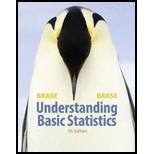
Concept explainers
Basic Computation: Testing
(a) Compute the pooled probability of success for the two experiments.
(b) Check Requirements What distribution does the sample test statistic follow? Explain.
(c) State the hypotheses.
(d) Compute
(c) Find the P-value of the sample test statistic.
(f) Conclude the test.
(g) Interpret the results.
(a)
To find: The pooled probability of success for the two experiments.
Answer to Problem 6P
Solution: The pooled probability of success for the two experiments is
Explanation of Solution
Calculation: Using,
Now, the pooled probability of success is calculated as follows:
The pooled probability of success is 0.36.
Now the value of the
The pooled probability of failure is 0.64.
(b)
Whether we should use normal distribution or not.
Answer to Problem 6P
Solution: The sample distribution follows standard normal distribution.
Explanation of Solution
The number of binomial trials is large enough that each of the products
(c)
The null and alternate hypothesis.
Answer to Problem 6P
Solution: The hypotheses are
Explanation of Solution
Since, we want to conduct a test of the claim that the probability of success for the second binomial experiment is greater than that for the first. Therefore the null hypothesis is
(d)
To find: The difference of sample proportion
Answer to Problem 6P
Solution: The difference of sample proportion
Explanation of Solution
Calculation:
The difference of
Thus, the difference of sample proportion
The sample test statistic is calculated as follows:
Thus, the sample test statistic is - 2.2
(e)
To find: The P-value of the sample test statistic.
Answer to Problem 6P
Solution: The P-value of test statistic is approximately 0.0134.
Explanation of Solution
Calculation:
The P-value is calculated as follows:
Using table 3 from Appendix, we get
Thus the P-value of the sample test statistic is approximately 0.0134.
(f)
Whether we should reject or fail to reject the null hypothesis for a 5% level of significance.
Answer to Problem 6P
Solution: The
Explanation of Solution
The P-value is less than the level of significance (
(g)
Interpretation for the result.
Answer to Problem 6P
Solution: We have sufficient evidence in the favor of the claim that the probability of success for the second binomial is greater than that for the first.
Explanation of Solution
The P-value is less than the level of significance (
Want to see more full solutions like this?
Chapter 10 Solutions
Understanding Basic Statistics
- Should you be confident in applying your regression equation to estimate the heart rate of a python at 35°C? Why or why not?arrow_forwardGiven your fitted regression line, what would be the residual for snake #5 (10 C)?arrow_forwardCalculate the 95% confidence interval around your estimate of r using Fisher’s z-transformation. In your final answer, make sure to back-transform to the original units.arrow_forward
- BUSINESS DISCUSSarrow_forwardA researcher wishes to estimate, with 90% confidence, the population proportion of adults who support labeling legislation for genetically modified organisms (GMOs). Her estimate must be accurate within 4% of the true proportion. (a) No preliminary estimate is available. Find the minimum sample size needed. (b) Find the minimum sample size needed, using a prior study that found that 65% of the respondents said they support labeling legislation for GMOs. (c) Compare the results from parts (a) and (b). ... (a) What is the minimum sample size needed assuming that no prior information is available? n = (Round up to the nearest whole number as needed.)arrow_forwardThe table available below shows the costs per mile (in cents) for a sample of automobiles. At a = 0.05, can you conclude that at least one mean cost per mile is different from the others? Click on the icon to view the data table. Let Hss, HMS, HLS, Hsuv and Hмy represent the mean costs per mile for small sedans, medium sedans, large sedans, SUV 4WDs, and minivans respectively. What are the hypotheses for this test? OA. Ho: Not all the means are equal. Ha Hss HMS HLS HSUV HMV B. Ho Hss HMS HLS HSUV = μMV Ha: Hss *HMS *HLS*HSUV * HMV C. Ho Hss HMS HLS HSUV =μMV = = H: Not all the means are equal. D. Ho Hss HMS HLS HSUV HMV Ha Hss HMS HLS =HSUV = HMVarrow_forward
 College AlgebraAlgebraISBN:9781305115545Author:James Stewart, Lothar Redlin, Saleem WatsonPublisher:Cengage Learning
College AlgebraAlgebraISBN:9781305115545Author:James Stewart, Lothar Redlin, Saleem WatsonPublisher:Cengage Learning Holt Mcdougal Larson Pre-algebra: Student Edition...AlgebraISBN:9780547587776Author:HOLT MCDOUGALPublisher:HOLT MCDOUGAL
Holt Mcdougal Larson Pre-algebra: Student Edition...AlgebraISBN:9780547587776Author:HOLT MCDOUGALPublisher:HOLT MCDOUGAL
 College Algebra (MindTap Course List)AlgebraISBN:9781305652231Author:R. David Gustafson, Jeff HughesPublisher:Cengage Learning
College Algebra (MindTap Course List)AlgebraISBN:9781305652231Author:R. David Gustafson, Jeff HughesPublisher:Cengage Learning



